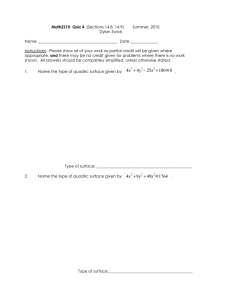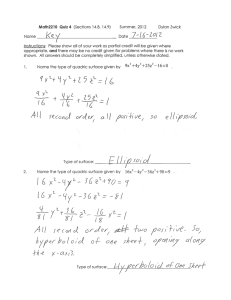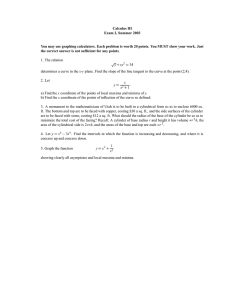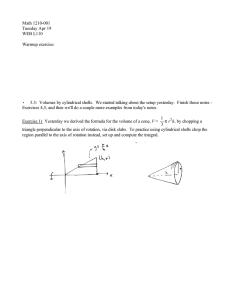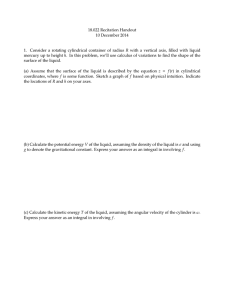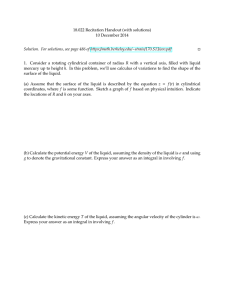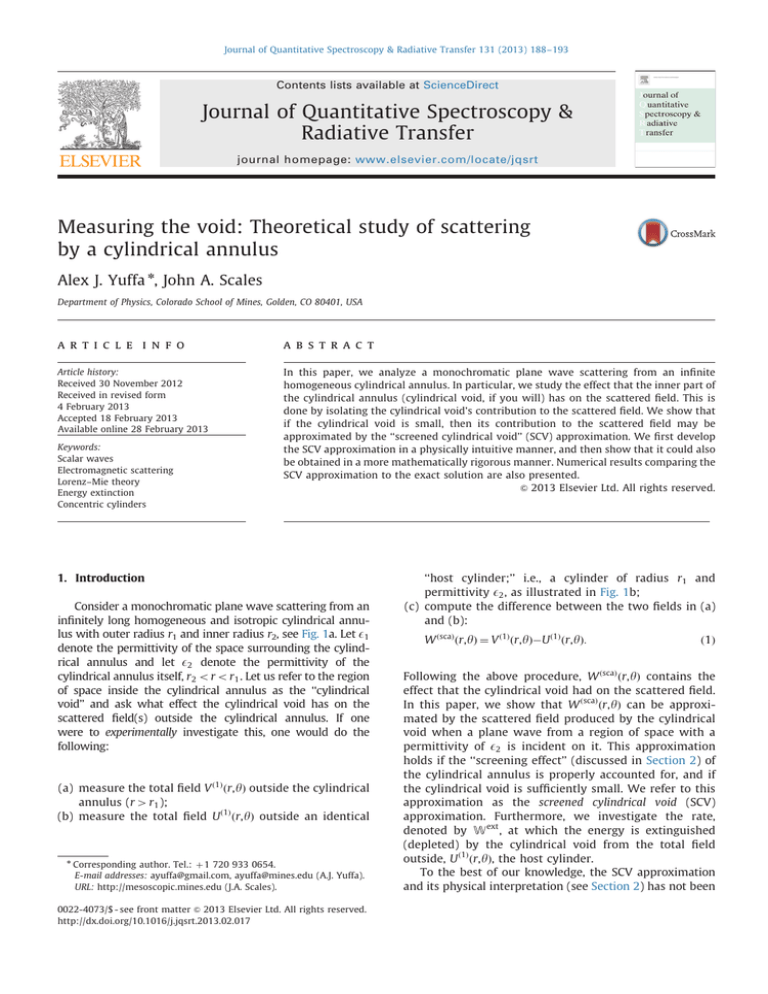
Journal of Quantitative Spectroscopy & Radiative Transfer 131 (2013) 188–193
Contents lists available at ScienceDirect
Journal of Quantitative Spectroscopy &
Radiative Transfer
journal homepage: www.elsevier.com/locate/jqsrt
Measuring the void: Theoretical study of scattering
by a cylindrical annulus
Alex J. Yuffa n, John A. Scales
Department of Physics, Colorado School of Mines, Golden, CO 80401, USA
a r t i c l e in f o
abstract
Article history:
Received 30 November 2012
Received in revised form
4 February 2013
Accepted 18 February 2013
Available online 28 February 2013
In this paper, we analyze a monochromatic plane wave scattering from an infinite
homogeneous cylindrical annulus. In particular, we study the effect that the inner part of
the cylindrical annulus (cylindrical void, if you will) has on the scattered field. This is
done by isolating the cylindrical void’s contribution to the scattered field. We show that
if the cylindrical void is small, then its contribution to the scattered field may be
approximated by the ‘‘screened cylindrical void’’ (SCV) approximation. We first develop
the SCV approximation in a physically intuitive manner, and then show that it could also
be obtained in a more mathematically rigorous manner. Numerical results comparing the
SCV approximation to the exact solution are also presented.
& 2013 Elsevier Ltd. All rights reserved.
Keywords:
Scalar waves
Electromagnetic scattering
Lorenz–Mie theory
Energy extinction
Concentric cylinders
1. Introduction
Consider a monochromatic plane wave scattering from an
infinitely long homogeneous and isotropic cylindrical annulus with outer radius r1 and inner radius r2, see Fig. 1a. Let E1
denote the permittivity of the space surrounding the cylindrical annulus and let E2 denote the permittivity of the
cylindrical annulus itself, r 2 or o r 1 . Let us refer to the region
of space inside the cylindrical annulus as the ‘‘cylindrical
void’’ and ask what effect the cylindrical void has on the
scattered field(s) outside the cylindrical annulus. If one
were to experimentally investigate this, one would do the
following:
(a) measure the total field V ð1Þ ðr, yÞ outside the cylindrical
annulus (r 4 r 1 );
(b) measure the total field U ð1Þ ðr, yÞ outside an identical
n
Corresponding author. Tel.: þ 1 720 933 0654.
E-mail addresses: ayuffa@gmail.com, ayuffa@mines.edu (A.J. Yuffa).
URL: http://mesoscopic.mines.edu (J.A. Scales).
0022-4073/$ - see front matter & 2013 Elsevier Ltd. All rights reserved.
http://dx.doi.org/10.1016/j.jqsrt.2013.02.017
‘‘host cylinder;’’ i.e., a cylinder of radius r1 and
permittivity E2 , as illustrated in Fig. 1b;
(c) compute the difference between the two fields in (a)
and (b):
W ðscaÞ ðr, yÞ ¼ V ð1Þ ðr, yÞU ð1Þ ðr, yÞ:
ð1Þ
Following the above procedure, W ðscaÞ ðr, yÞ contains the
effect that the cylindrical void had on the scattered field.
In this paper, we show that W ðscaÞ ðr, yÞ can be approximated by the scattered field produced by the cylindrical
void when a plane wave from a region of space with a
permittivity of E2 is incident on it. This approximation
holds if the ‘‘screening effect’’ (discussed in Section 2) of
the cylindrical annulus is properly accounted for, and if
the cylindrical void is sufficiently small. We refer to this
approximation as the screened cylindrical void (SCV)
approximation. Furthermore, we investigate the rate,
denoted by Wext , at which the energy is extinguished
(depleted) by the cylindrical void from the total field
outside, U ð1Þ ðr, yÞ, the host cylinder.
To the best of our knowledge, the SCV approximation
and its physical interpretation (see Section 2) has not been
A.J. Yuffa, J.A. Scales / Journal of Quantitative Spectroscopy & Radiative Transfer 131 (2013) 188–193
189
Fig. 1. The cross-sectional view of the cylindrical scattering objects is shown. The origin of the coordinate system ðr, yÞ, where p r y o p, is concentric
with the cylindrical objects. In each panel, the region is denoted by a boxed number and the permittivity of each region is also indicated. For example,
region three, r o r 2 , in panel (a) has a permittivity of E1 and region one, r 4r 2 , in panel (c) has a permittivity of E2 .
previously considered in the literature. In order to make
the paper accessible to the widest possible scientific
community, we use the well-known Lorenz–Mie theory
[1–4] to derive the SCV approximation. However, we do
note that our intuitive derivation of the SCV approximation, which is presented in Section 2, is physically guided by
the Debye series expansion [5]. In short, the Debye series
expansion consists of re-expressing each Mie scattering
coefficient in terms of an infinite series called the Debye
series. Each term in the Debye series may be physically
interpreted in terms of the number of reverberations the
wave has experienced. A reader interested in the use of the
Debye series expansion in the context related to this paper,
namely, plane wave scattering by a multilayered cylinder,
may consult [6,7] and references therein.
Although we do not explicitly consider many diverse
areas of science where the scattering by a cylindrical void
is important (e.g., see [3,4]), we would like to mention one,
namely, localization. Fifty years after the publication of
Anderson’s seminal work [8], localization continues to be a
thriving area of research [9] in theoretical and experimental
physics. Localization of millimeter/submillimeter electromagnetic waves is particularly interesting because both the
amplitude and the phase of the electromagnetic field can
be easily measured with a vector network analyzer [10].
At these wavelengths, the preparation of disordered samples
is also inexpensive and straightforward with standard
computer-numerically-controlled (CNC) milling techniques.
A sample may be prepared by drilling small holes in a large
Teflon (ultra low-loss material) cylinder. Further, by illuminating the sample from the side and putting it on a rotational
stage, we can generate essentially arbitrary realizations of the
same random disorder. When the number of small scatterers
is large, say, over 1000, then what is important is the rate at
which the scatterer extinguishes the energy from the incident
field, rather than the geometrical shape/size of each individual scatterer [11,12]. Thus, the physical insight into scattering by a single small cylindrical void discussed in this paper
may be of benefit in understanding the experimental model
described above.
Throughout this paper, we will use the Gaussian unit
system, and we will assume that all fields are harmonic in
time with a expðiotÞ time factor, where o is the angular
frequency. Furthermore, we will assume that all fields are
^
^
polarized in the positive z-direction.
The positive z-direction
is out of the page in Fig. 1. All media considered in this paper
are assumed to be non-magnetic, and E1 is assumed to be
purely real.
2. Intuitive derivation of the SCV approximation
In this section, a physically intuitive derivation of the
SCV approximation is presented. The derivation is organized as follows. First, we imagine a unit plane wave
uðincÞ ðr, yÞ incident from region one onto the cylindrical
void shown in Fig. 1c. Then, we compute the scattered
field uðscaÞ ðr, yÞ in region one generated by the scattering of
uðincÞ ðr, yÞ from the cylindrical void. Second, to account for
the screening effect of the cylindrical annulus, we use the
previously found scattered field uðscaÞ ðr, yÞ as the incident
(primary) field, i.e., wðincÞ ðr, yÞ uðscaÞ ðr, yÞ, originating from
the center of the host cylinder shown in Fig. 1b. Finally,
we compute the total field wð1Þ ðr, yÞ in region one shown in
Fig. 1b and physically interpret the terms contained in it
to obtain an approximation to W ðscaÞ ðr, yÞ, see (1).
Let us note that all fields in this paper satisfy the twodimensional (2D) Helmholtz equation. The radial solution
of the 2D Helmholtz equation is composed of a linear
combination of integer order Bessel functions of the first
and second kind, which we denote by J n ðxÞ and Y n ðxÞ,
respectively. The Bessel functions Jn ðxÞ and Y n ðxÞ also
satisfy the Wronskian relationship [13], namely
J n þ 1 ðxÞY n ðxÞJ n ðxÞY n þ 1 ðxÞ ¼
2
px
:
ð2aÞ
Also, J n ðxÞ, Y n ðxÞ and the Hankel function of the first kind,
which we denote by Hn ðxÞ ¼ J n ðxÞ þ iY n ðxÞ, satisfy the
recurrence relation [13]
d
n
Cn ðxÞ ¼ Cn ðxÞCn þ 1 ðxÞ,
dx
x
ð2bÞ
where C denotes J, Y or H. Lastly, we note the
Jacobi–Anger expansion of a plane wave [13], namely,
eix cos y ¼
1
X
n¼0
g n in J n ðxÞ cosðnyÞ,
ð2cÞ
190
A.J. Yuffa, J.A. Scales / Journal of Quantitative Spectroscopy & Radiative Transfer 131 (2013) 188–193
where gn denotes the Neumann factor: g 0 ¼ 1 and gn ¼2
for n Z1.
Returning to the scattering of the unit plane wave from
the cylindrical void shown in Fig. 1c, let the incident wave
pffiffiffiffiffi
be uðincÞ ðr, yÞ ¼ expðik2 r cos yÞ, where k2 ¼ E2 o=c is the
wavenumber and c is the speed of light in a vacuum. Then,
the field in region two uð2Þ ðr, yÞ, and the total field in
region one decomposed as uð1Þ ðr, yÞ ¼ uðincÞ ðr, yÞ þ uðscaÞ ðr, yÞ,
may be written as
2 ðincÞ
3
2
3
J n ðk2 rÞ
ðr, yÞ
u
1
X
6 uðscaÞ ðr, yÞ 7
6
7
g n in 4 dn Hn ðk2 rÞ 5cosðnyÞ,
ð3Þ
4
5¼
n¼0
gn Jn ðk1 rÞ
uð2Þ ðr, yÞ
pffiffiffiffiffi
where k1 ¼ E1 o=c. In writing (3), we used the Jacobi–
Anger expansion (2c) to rewrite expðik2 r cos yÞ as an
infinite sum, imposed the Sommerfeld radiation (outgoing
cylindrical wave) condition on uðscaÞ ðr, yÞ, and required
uð2Þ ðr, yÞ to be regular (finite) at r ¼0. To find the unknown
coefficients in (3), we require that the electric field and its
normal derivative be continuous across the r ¼ r 2 interface, i.e.,
uð1Þ ¼ uð2Þ
and
@ ð1Þ
@
u ¼ uð2Þ
@r
@r
on r ¼ r 2 ,
ð4Þ
to obtain a system of linear equations. Solving this system
of linear equations for dn and using (2b) to simplify the
result, yields
dn ¼ J n þ 1 ðk1 r 2 ÞJ n ðk2 r 2 ÞkJn ðk1 r 2 ÞJ n þ 1 ðk2 r 2 Þ
,
Jn þ 1 ðk1 r 2 ÞHn ðk2 r 2 ÞkJn ðk1 r 2 ÞHn þ 1 ðk2 r 2 Þ
ð5aÞ
where k ¼ k2 =k1 , n 2 Z þ and Z þ denotes the set of all
nonnegative integers. It is convenient to introduce curly
bracket notation, fCn þ 1 ðxÞ, FðZÞg, by which we mean
Cn þ 1 ðxÞ, Fn ðZÞ ðCn þ 1 ðxÞFn ðZÞkCn ðxÞFn þ 1 ðZÞÞ:
For example, (5a) in the curly bracket notation reads as
J
ðk1 r 2 Þ,J n ðk2 r 2 Þ
, n 2 Zþ :
dn ¼ n þ 1
ð5bÞ
Jn þ 1 ðk1 r 2 Þ,Hn ðk2 r 2 Þ
Having found the expansion coefficients of the scattered
wave uðscaÞ ðr, yÞ, we are now ready to see how they should
be modified in order to account for the screening effect of
the cylindrical annulus.
Imagine a ‘‘line-source’’ embedded in the center of the
host cylinder shown in Fig. 1b. We take the field produced
by the line-source to be equal to uðscaÞ ðr, yÞ in (3). If we use
this field as the incident field, i.e., wðincÞ ðr, yÞ uðscaÞ ðr, yÞ,
then the total field wð2Þ ðr, yÞ inside the host cylinder
(region two in Fig. 1b) may be written as wð2Þ ðr, yÞ ¼
wðincÞ ðr, yÞ þ wðscaÞ ðr, yÞ, where
ðscaÞ
w
ðr, yÞ ¼
1
X
n
g n i bn J n ðk2 rÞ cosðnyÞ:
Sommerfeld radiation condition and thus, it is given by
wð1Þ ðr, yÞ ¼
1
X
g n in an Hn ðk1 rÞ cosðnyÞ:
ð6bÞ
n¼0
Imposing the boundary conditions wð1Þ ¼ wð2Þ and ð@=@rÞ
wð1Þ ¼ ð@=@rÞwð2Þ on r ¼ r 1 , then solving the resultant linear
system for an and using (2a) with (2b) to simplify the
result yields
2i
an ¼
d , n 2 Zþ :
ð7Þ
pk1 r 1 fHn þ 1 ðk1 r1 Þ,Jn ðk2 r1 Þg n
We physically interpret the term in parentheses in (7) as
the screening effect of the cylindrical annulus on the
scattered wave generated by the cylindrical void. The an
coefficients are not quite the correct ones to use in
W ðscaÞ ðr, yÞ because they do not contain the screening
effect that the cylindrical annulus had on the incident
wave. A moment’s thought reveals that this screening
effect had to be the same as the screening effect on the
scattered wave. Thus, the W ðscaÞ ðr, yÞ expansion coefficients should be given by (7) with the parenthesis term
squared. Therefore, W ðscaÞ ðr, yÞ is approximately given by
!2
1
X
2i
n
ðscaÞ
ðr, yÞ ffi
gn i
W
pk1 r1 Hn þ 1 ðk1 r1 Þ,Jn ðk2 r1 Þ
n¼0
dn Hn ðk1 rÞ cosðnyÞ,
ð8Þ
where the dn coefficients are given by (5).
3. Rigorous derivation of the SCV approximation
In this section, we present a rigorous derivation of
W ðscaÞ ðr, yÞ by directly computing U ð1Þ ðr, yÞ and V ð1Þ ðr, yÞ
(recall the bullet list of Section 1). Once the exact
W ðscaÞ ðr, yÞ is found, we show that it is approximately
equal to (8) if k1 r 2 51 and 9k2 9r 2 51. Furthermore, a
numerical illustration of the SCV approximation is also
presented.
If a plane wave, U ðincÞ ðr, yÞ ¼ expðik1 r cos yÞ, is incident
on the host cylinder shown in Fig. 1b, then by proceeding
as in paragraph three of Section 2, the total field in region
one is U ð1Þ ðr, yÞ ¼ U ðincÞ ðr, yÞ þ U ðscaÞ ðr, yÞ, where the scattered
field is
U ðscaÞ ðr, yÞ ¼
1
X
g n in AðhcÞ
n H n ðk1 rÞ cosðnyÞ
ð9aÞ
n¼0
with
J n þ 1 ðk1 r 1 Þ,J n ðk2 r 1 Þ
,
Hn þ 1 ðk1 r 1 Þ,Jn ðk2 r 1 Þ
¼
AðhcÞ
n
n 2 Zþ ,
ð9bÞ
and the field in region two is given by
U ð2Þ ðr, yÞ ¼
1
X
g n in BnðhcÞ J n ðk2 rÞ cosðnyÞ:
ð9cÞ
n¼0
ð6aÞ
n¼0
Notice that in (6a), we required wðscaÞ ðr, yÞ to be regular at
r ¼0. This requirement is necessary because we are
essentially treating the cylindrical void as a line-source
in this paragraph. The field outside the host cylinder
(region one in Fig. 1b), wð1Þ ðr, yÞ, must satisfy the
The superscript ðhcÞ on the expansion coefficients in (9) is
meant to remind the reader that these expansion coefficients are for the host cylinder.
Turning our attention to the cylindrical annulus shown
in Fig. 1a, if we think of the cylindrical annulus as the host
cylinder into which a scatterer, namely, the cylindrical
void, has been inserted, then, the total fields in regions
A.J. Yuffa, J.A. Scales / Journal of Quantitative Spectroscopy & Radiative Transfer 131 (2013) 188–193
191
one, two, and three may be written as V ð1Þ ðr, yÞ ¼
U ð1Þ ðr, yÞ þ W ðscaÞ ðr, yÞ, V ð2Þ ðr, yÞ ¼ U ð2Þ ðr, yÞ þ W ð2Þ ðr, yÞ and
V ð3Þ ðr, yÞ ¼ W ð3Þ ðr, yÞ, respectively. Noting that the W-fields
also satisfy the 2D Helmholtz equation and imposing the
Sommerfeld radiation condition on W ðscaÞ ðr, yÞ, as well as
requiring W ð3Þ ðr, yÞ to be regular at r ¼0 yields
2
3
2 ðscaÞ
3
AðcvÞ
W
ðr, yÞ
n H n ðk1 rÞ
1
X
6 ðcvÞ
7
6
7
ðcvÞ
ð2Þ
7
g n in 6
4 W ðr, yÞ 5 ¼
4 Bn J n ðk2 rÞ þC n Y n ðk2 rÞ 5cosðnyÞ:
ð3Þ
n¼0
W ðr, yÞ
DðcvÞ
J
ðk
rÞ
n 1
n
ð10Þ
The superscript ðcvÞ on the expansion coefficients in (10)
reminds us of the presence of the cylindrical void.
To find the unknown coefficients in (10), we require that
the V-fields and their normal derivatives be continuous
across the r ¼ r 1 interface, as well as the r ¼ r 2 interface to
obtain
2
32 ðcvÞ 3
An
Y n ðk2 r 1 Þ
0
Hn ðk1 r 1 Þ Jn ðk2 r 1 Þ
7
6
76
ðcvÞ
0
0
0
6
0
6 Hn ðk1 r 1 Þ kJ n ðk2 r 1 Þ kY n ðk2 r 1 Þ
7 6 Bn 7
7
6
76
ðcvÞ 7
6
Y n ðk2 r 2 Þ J n ðk1 r 2 Þ 7
0
Jn ðk2 r 2 Þ
7
C
4
56
n
4
5
kJ0n ðk2 r 2 Þ kY 0n ðk2 r 2 Þ J0n ðk1 r2 Þ DðcvÞ
0
n
|fflfflfflfflfflfflfflfflfflfflfflfflfflfflfflfflfflfflfflfflfflfflfflfflfflfflfflfflfflfflfflfflfflfflfflfflfflfflfflfflfflfflfflfflfflfflfflffl{zfflfflfflfflfflfflfflfflfflfflfflfflfflfflfflfflfflfflfflfflfflfflfflfflfflfflfflfflfflfflfflfflfflfflfflfflfflfflfflfflfflfflfflfflfflfflfflffl}
¼M
2
3
ðhcÞ
J n ðk1 r 1 Þ þ AðhcÞ
n H n ðk1 r 1 ÞBn J n ðk2 r 1 Þ
6 0
7
6 J ðk1 r 1 Þ þAðhcÞ H0 ðk1 r 1 ÞkBðhcÞ J 0 ðk2 r 1 Þ 7
n
n
n
n
6 n
7
¼6
7,
6
7
BðhcÞ
n J n ðk2 r 2 Þ
4
5
ð11Þ
Fig. 2. The magnitude and phase of the far-field pattern in the forward
direction for a Teflon cylindrical annulus in vacuum, with an outer
radius of 10 cm at 100 GHz, is shown. The permittivity of Teflon at
100 GHz is 2.05 with a negligible loss-tangent [10]. In the computation
of (16), we only summed the first N ¼ dk1 r 2 þ 4ðk1 r 2 Þ1=3 þ 2e terms
[3, Appendix C].
The AðcvÞ
coefficients in (13) are the exact expansion
n
coefficients of W ðscaÞ ðr, yÞ. To obtain the approximate
coefficients, we first note that Y n ðk2 r 2 Þ iHn ðk2 r 2 Þ) if
9k2 9r 2 5 1 [13], which allows us to rewrite (13) as
AnðcvÞ ffii
2
pk1 r1
2
1
Hn þ 1 ðk1 r1 Þ,J n ðk2 r1 Þ
0
kBðhcÞ
n J n ðk2 r 2 Þ
and the prime denotes the derivative with respect to the
argument. Solving (11) for AðcvÞ
and using (2b) to simplify
n
the result, yields
detðMÞAðcvÞ
¼ J n þ 1 ðk1 r 2 Þ,J n ðk2 r 2 Þ
n
AðhcÞ
Hn þ 1 ðk1 r 1 Þ,Y n ðk2 r 1 Þ
n
þ J n þ 1 ðk1 r 1 Þ,Y n ðk2 r 1 Þ ,
ð14Þ
where dn is given by (5). To develop (14) further, we note
that 9dn 9 5 1 if k1 r 2 5 1 and 9k2 9r 2 5 1, as can be seen from
the small argument forms of J n ðxÞ and Hn ðxÞ [13]. Therefore, we can expand (14) in powers of dn to finally obtain
ð12aÞ
AðcvÞ
n
where
detðMÞ ¼ Hn þ 1 ðk1 r 1 Þ,Y n ðk2 r 1 Þ Jn þ 1 ðk1 r 2 Þ,J n ðk2 r 2 Þ
Hn þ 1 ðk1 r 1 Þ,J n ðk2 r 1 Þ J n þ 1 ðk1 r 2 Þ,Y n ðk2 r 2 Þ :
ð12bÞ
To simplify (12a) further, we use (9b) and note that
Y n þ 1 ðk1 r 1 Þ,Y n ðk2 r 1 Þ J n þ 1 ðk1 r 1 Þ,J n ðk2 r 1 Þ
Y n þ 1 ðk1 r 1 Þ,J n ðk2 r 1 Þ J n þ 1 ðk1 r 1 Þ,Y n ðk2 r 1 Þ ¼
2
pk1 r1
2
to obtain
AðcvÞ
¼
n
2 J
ðk r Þ,J ðk r Þ
i
2
nþ1 1 2 n 2 2 ,
detðMÞ pk1 r1
Hn þ 1 ðk1 r1 Þ,J n ðk2 r1 Þ
!
d
n ,
Hn þ 1 ðk1 r 1 Þ,Y n ðk2 r 1 Þ dn i Hn þ 1 ðk1 r1 Þ,J n ðk2 r 1 Þ
n 2 Zþ :
ð13Þ
pk1 r1
2i
Hn þ 1 ðk1 r 1 Þ,J n ðk2 r 1 Þ
!2
dn , n 2 Z þ :
ð15Þ
coefficients are identical to the
Notice that the above AðcvÞ
n
expansion coefficients given in (8) of Section 2.
To numerically illustrate the SCV approximation, the
far-field pattern of W ðscaÞ ðr, yÞ in the forward direction,
y ¼ 0, as a function of k2 r 2 is shown in Fig. 2. The far-field
pattern of W ðscaÞ ðr, yÞ is defined by
FðyÞ ¼ 1
X
g n AðcvÞ
cosðnyÞ:
n
ð16Þ
n¼0
From Fig. 2, we see that the exact (computed with (13))
and the approximate (computed with (15)) far-field
patterns are in good agreement for small k2 r 2 , say,
k2 r 2 o0:3. Also from Fig. 2, we see that the SCV approximation becomes progressively worse as k2 r 2 approaches
unity. This is expected as the SCV approximation requires
that both k1 r 2 and k2 r 2 are much smaller than unity.
192
A.J. Yuffa, J.A. Scales / Journal of Quantitative Spectroscopy & Radiative Transfer 131 (2013) 188–193
160
4. Energy conservation
In this section, we present a relationship between the
rate at which the energy is extinguished by the cylindrical
void from the U ð1Þ ðr, yÞ field. Also, a numerical example
illustrating that the SCV approximation is in good agreement with the derived energy conservation relationship is
presented.
We begin by constructing an imaginary concentric
cylinder of radius R 4r 1 and length L around the host
ðabsÞ
cylinder shown in Fig. 1b. Then, the rate WU
at which
the energy is absorbed within the imaginary concentric
cylinder is given by
Z p
WUðabsÞ ¼ RL
SU r^ dy,
ð17aÞ
140
120
100
2.0
1.5
1.0
80
0.5
60
0.0
0.00 0.05 0.10 0.15 0.20 0.25 0.30
40
exact
20
0
0.0
approx.
0.2
0.4
0.6
0.8
1.0
p
where r^ ¼ cos y x^ þsin y y^ (see Fig. 1), and the timeaveraged Poynting vector is given by
1
ic ð1Þ ð1Þ n
SU ¼ Re
U r U
:
ð17bÞ
2
4pk
In (17b), Re denotes the real part, n denotes the complex
conjugate, and k ¼ o=c. Now, we consider the rate WVðabsÞ
at which the energy is absorbed by the cylindrical annulus.
By proceeding as before, we immediately obtain
WðabsÞ
¼ RL
V
Z p
p
SV r^ dy,
where SV ¼
1
ic ð1Þ
Re
V rðV ð1Þ Þn :
2
4pk
ð18Þ
Substituting V ð1Þ ¼ U ð1Þ þW ðscaÞ into (18) and using (17) to
simplify the result yields
Wext ¼ WVðabsÞ WUðabsÞ þ WðscaÞ
W ,
ð19aÞ
where
Wext ¼ RLc
8 pk
Z p
n
n r^ dy
Re iU ð1Þ r W ðscaÞ þiW ðscaÞ r U ð1Þ
ð19bÞ
p
and
WðscaÞ
¼
W
RLc
8pk
Z p
n Re iW ðscaÞ r W ðscaÞ
r^ dy:
ð19cÞ
p
We interpret Wext as the rate at which the energy is
extinguished by a scatterer, namely, the cylindrical void,
in the presence of the host cylinder. In other words, it is
the rate at which the energy is depleted by the cylindrical
void from the total field, U ð1Þ , outside the host cylinder.
Moreover, from (19) we see that if the cylindrical annulus
is nonabsorbing (E2 is purely real), then Wext ¼ WðscaÞ
W .
Finally, substituting U ð1Þ ðr, yÞ and W ðscaÞ ðr, yÞ (see (9a) and
(10)) into (19b), and then integrating the result over y
yields
Wext ¼ 1
ðhcÞ n Lc X
g Re AðcvÞ
þ 2Re AðcvÞ
An
:
n
n
2pk n ¼ 0 n
ð20Þ
We interpret the first term in (20) as the rate at which
W ðscaÞ extinguishes energy from U ðincÞ , and the second
term as the rate at which W ðscaÞ extinguishes energy from
U ðscaÞ .
To illustrate that the SCV approximation is in good
agreement with the energy conservation principle, we
compute Wext using the exact and approximate AðcvÞ
n
coefficients. Recall that the exact AðcvÞ
coefficients are
n
given by (13), and the approximate coefficients by (15).
Fig. 3. The rate Wext (normalized by Lc=8p) at which energy is
extinguished by the cylindrical void from the total field outside the
host cylinder is shown as a function of k2 r 2 . The above plot was
produced with the same parameters as the ones described in the caption
of Fig. 2.
The results of the above-mentioned computations are
shown in Fig. 3. From Fig. 3, we see that the SCV approximation conserves energy to roughly 10% for k2 r 2 r 1,
which does indicate that the SCV approximation is in
good agreement with the energy conservation principle.
5. Conclusions
In this paper, we investigated a monochromatic plane
wave scattering from a solid homogeneous cylinder (host
cylinder) and a cylindrical annulus, referring to the inner part
of the cylindrical annulus as the cylindrical void. It was
shown that if the cylindrical void is thought of as a scatterer
inserted into the host cylinder, then the scattered field due to
the cylindrical void may be approximated by the screened
cylindrical void (SCV) approximation, see Section 2. The SCV
approximation was derived intuitively in Section 2 and
rigorously in Section 3. Furthermore, a formula for the rate
at which energy is depleted by the cylindrical void from the
total field outside the host cylinder was derived in Section 4.
The numerical examples in Sections 3 and 4 showed that the
SCV approximation is in good agreement with the exact
solution if the cylindrical void is small.
Acknowledgments
This material is based upon work supported in part by
the U.S. Office of Naval Research as a Multi-disciplinary
University Research Initiative on Sound and Electromagnetic Interacting Waves under grant number N00014-101-0958.
References
[1] Kerker M. The scattering of light and other electromagnetic radiation. New York: Academic Press; 1969.
[2] van de Hulst HC. Light scattering by small particles. New York:
Dover; 1981.
A.J. Yuffa, J.A. Scales / Journal of Quantitative Spectroscopy & Radiative Transfer 131 (2013) 188–193
[3] Bohren CF, Huffman DR. Absorption and scattering of light by small
particles. New York: John Wiley & Sons; 1983.
[4] Gouesbet G. Generalized Lorenz–Mie theories, the third decade: a
perspective. J Quant Spectrosc Radiat Transfer 2009;110:1223–38.
[5] Debye P. Das elektromagnetische feld um einen zylinder
und die theorie des regenbogens. Phys Z 1908;9:775–8.
(Reprinted and translated into English in P.L. Marston (Ed.),
Geometrical Aspects of Scattering, volume MS89 of Milestone
Series, SPIE, Bellingham, Wash., 1994, pp. 198–204.).
[6] Li R, Han X, Jiang H, Ren KF. Debye series of normally incident
plane-wave scattering by an infinite multilayered cylinder. Appl
Opt 2006;45:6255–62.
[7] Li R, Han X, Ren KF. Generalized Debye series expansion of
electromagnetic plane wave scattering by an infinite multilayered
cylinder at oblique incidence. Phys Rev E 2009;79:036602.
193
[8] Anderson PW. Absence of diffusion in certain random lattices. Phys
Rev 1958;109:1492–505.
[9] Lagendijk A, van Tiggelen B, Wiersma DS. Fifty years of Anderson
localization. Phys Today 2009;62:24–9.
[10] Scales JA, Carr LD, McIntosh DB, Freilikher V, Bliokh YP. Millimeter
wave localization: slow light and enhanced absorption in random
dielectric media. Phys Rev B 2007;76:085118.
[11] Rusek M, Or"owski A. Analytical approach to localization of electromagnetic waves in two-dimensional random media. Phys Rev E
1995;51:R2763–6.
[12] Rusek M, Or"owski A. Example of self-averaging in three dimensions: Anderson localization of electromagnetic waves in random
distributions of pointlike scatterers. Phys Rev E 1997;56:6090–4.
[13] Abramowitz M, Stegun IA, editors. Handbook of mathematical
functions. New York: Dover; 1965.

